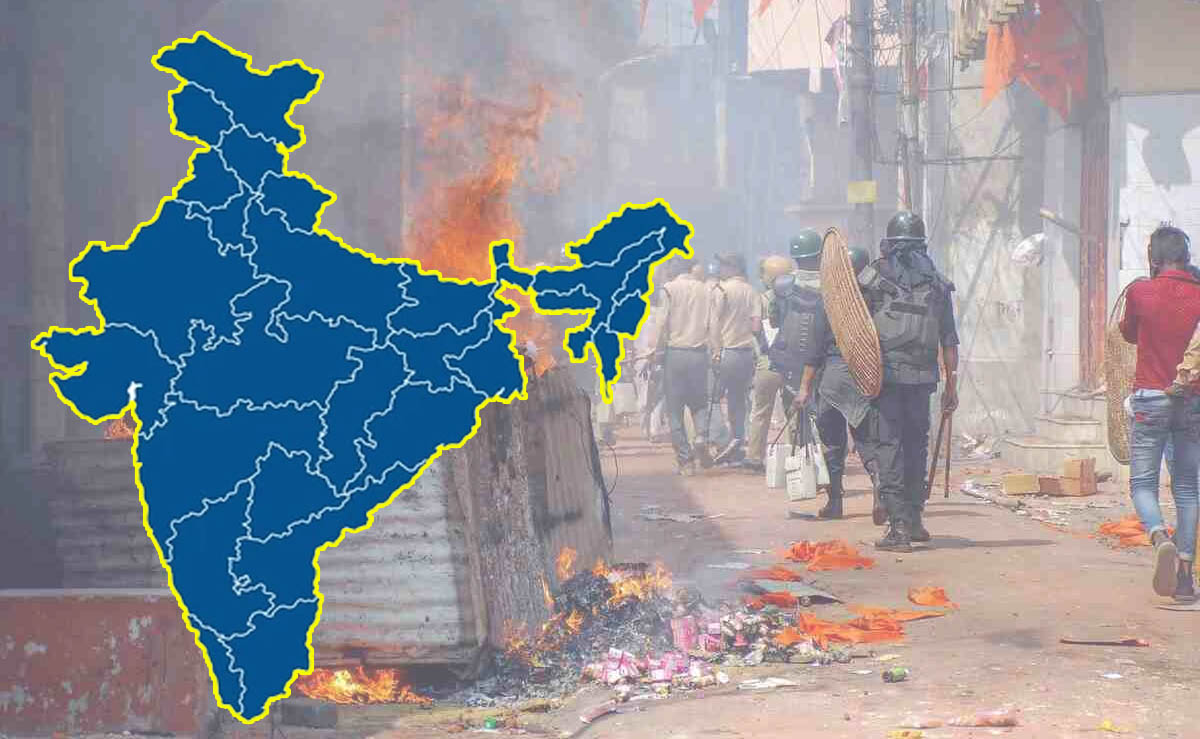Fifty-nine incidents of communal violence dotted the Indian landscape in the year 2024 according to a report being compiled by the Centre Study of Society and Secularism (CSSS). The exercise that includes a monitoring of newspaper reports (Indian Express, Times of India, The Hindu, Shahafat, and Inquilab), suggests a sharp increase of 84% from 32 communal riots reported in the previous year, 2023. Not surprisingly, given the electoral scene (general elections from April-May 2024 and state assembly elections in November), Maharashtra witnessed the highest number of communal riots (at 12 documented incidents, followed by Uttar Pradesh and Bihar, with seven each.
Maharashtra, with a mixed history of intra-community conflict, has in 2024 under a BJP-SS (Eknath Shinde-NCP (Ajit Pawar) regime emerged as a communal hotbed in the year 2024 with the highest number of communal riots and mob lynching incidents. These communal riots claimed 13 lives- three of whom were Hindus and ten of whom were Muslims. The majority of communal riots were triggered during religious festivals or processions, including Pran Pratishthan at Ayodhya Ram Mandir (four riots in January), Saraswati Puja immersions (seven), Ganesh festivals (four), and Bakri Eid (two). This data underscores how religious celebrations are increasingly being exploited as triggers for communal tensions and political mobilisation.
Citizens for Justice and Peace’s Hate Watch programme meticulously monitors day on day such incidents and also gives a visual representation of the same on Nafrat ka Naqsha that can be viewed here.
In addition to the communal riots, 12 incidents of mob lynching were reported in the year 2024, resulting in 10 deaths: one Hindu, one Christian, and eight Muslims. While this represents a decline from 21 mob lynching incidents recorded in the year 2023, the persistence of these attacks remains a concern. Six of these lynchings were linked to cow vigilantism or accusations of cow slaughter. Other cases of lynching were on the pretext of interfaith relationships and assaults targeting Muslims for their religious identity. Geographically, Maharashtra accounted for three lynchings, while Chhattisgarh, Gujarat, Haryana, and Uttar Pradesh each reported two incidents, and Karnataka recorded one.
The data analysed reveals a troubling trend: while mob lynching incidents decreased, communal riots reported as reported in these five newspapers surged by nearly 84%. Together, these developments signify an escalation of communal tensions and the marginalisation of Indian Muslims, further threatening the secular fabric of Indian society. The rise in the number of communal riots can be attributed to the General Elections that were held in April/May in 2024 and state assembly elections in the states of Maharashtra, Jharkhand and Haryana. Similarly, the intervention of judicial interventions — calling upon the state to take action against mob lynching especially after Hindus were victims of mob lynching– have resulted in lesser incidents of mob lynching.
On the basis of its annual monitoring exercise, the CSSS based has released these trends of communal violence in India during 2024. The year saw a disturbing shift towards more institutionalized forms of violence, characterised primarily by attacks on places of religious worship and attempts by fringe Hindu right-wing groups to push for archaeological surveys of historic mosques and dargahs, including the Ajmer Sharif Dargah. These actions reflect a concerted effort to reshape India’s socio-political and cultural landscape.
This trend was accompanied by significant legislative changes, such as the introduction of the Uniform Civil Code in Uttarakhand and amendments to the Waqf Board Act. Additionally, the use of bulldozers to demolish properties owned by Muslims without due legal process continued unabated from 2023, symbolising the (mis) use of state power –where governments belong to the Bharaitya Janata Party (BJP) played a large part [1]–being wielded disproportionately against the Muslim community. Bulldozers in the years 2023 and 2024 have become synonymous with a kind of “collective punishment” meted out to the Muslims. Ironically, bulldozers are used to punish Muslims when they are victims of the same communal riots. Furthermore, an increase in communal riots, particularly during religious festivals, has heightened concerns about the erosion of India’s secular and composite cultural fabric.
A more detailed analysis is expected to follow this brief interim report.
[1] The hill states of Uttarakhand and Himachal Pradesh (governed by the Indian National Congress-INC have also witnessed acute communal polarization with the miniscule Muslim minority population being targeted through slurs, hate speech and attacks on places of worship (Sanjauli and Nandi masjids) https://sabrangindia.in/tensions-escalate-in-himachal-and-uttarakhand-multiple-protest-and-rallies-against-mosques/
Related:
Temple-mosque politics: Right Wing’s communal hit list getting longer?

